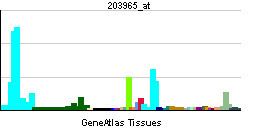Entrez 10868 | Ensembl ENSG00000136878 | |
 | ||
External IDs MGI: 1921520 HomoloGene: 4861 GeneCards: USP20 | ||
Ubiquitin carboxyl-terminal hydrolase 20 is an enzyme that in humans is encoded by the USP20 gene.
Contents
- Gene
- Structure
- Function
- Thyronine deiodinase type 2
- Hypoxia inducible factor 1
- 2 adrenergic receptor
- Regulation
- Model organisms
- References
Ubiquitin-specific protease 20 (USP20), also known as ubiquitin-binding protein 20 and VHL protein-interacting deubiquitinating enzyme 2 (VDU2), is a cysteine protease deubiquitinating enzyme (DUB). The catalytic site of USP20, like other DUBs, contains conserved cysteine and histidine residues that catalyse the proteolysis of an isopeptide bond between a lysine residue of a target protein and a glycine residue of a ubiquitin molecule. USP20 is known to deubiquitinate a number of proteins including thyronine deiodinase type 2 (D2), Hypoxia-inducible factor 1α (HIF1α), and β2 adrenergic receptor (β2AR).
Gene
The USP20 gene is located on chromosome 9 at the locus 9q34.11.
Structure
USP20 is a 914-amino acid protein that shows 59% homology with another DUB, USP33. It contains 4 known domains, an N-terminal Zf UBP domain, a catalytic domain containing conserved histidine and cysteine residues, and two C-terminal DUSP domains.
Function
DUBs are categorised into 5 main groups, ubiquitin-specific proteases (USP), ubiquitin c-terminal hydrolases (UCH), ovarian tumour proteases (OTU), Machado-Joseph disease proteases (MJD), and JAB1/MPN/MOV34 proteases (JAMM/MPN+). The first four groups are cysteine proteases, whereas the last group are Zn metalloproteases. USP20 belongs to the USP group and, like most DUBs, catalyse the breakage of an isopeptide bond between a lysine residue of the target protein and the terminal glycine residue of a ubiquitin protein. This occurs via a conserved cysteine and histidine residue in the catalytic site of the enzyme. The histidine molecule is protonated by the cysteine residue and this allows the cystein residue to undergo a nucleophillic attack on the isopeptide bond, which removes the ubiquitin from the substrate protein.
Thyronine deiodinase type 2
USP20 deubiquitinates thyronine deiodinase type 2 (D2), an enzyme that converts thyroxine (T4) into active 3,5,3'-triiodothyronine (T3). D2 is ubiquitinated after binding of T4, which signals for the degradation of D2 via the proteasome and also causes an inactivating conformational change of the protein. Deubiquitination by USP20 rescues D2 from degradation and also returns D2 to its active conformation.
Hypoxia inducible factor 1α
The von Hippel-Lindau tumour suppressor protein (pVHL) ubiquitinates hypoxia-inducible factor 1α (HIF1α) when cell oxygen levels are normal. This leads to the degradation of HIF1α and prevents the transcription of hypoxic response genes such as vascular endothelial growth factor, platelet-derived growth factor B, and erythropoietin. USP20 deubiquitinates HIF1α, preventing its proteasomal degradation, and allows it to transcribe the hypoxic response genes.
β2 adrenergic receptor
USP20 is involved in the recycling of the β2-adrenergic receptor. After agonist stimulation, the receptor is internalised and ubiquitinated. USP20 serves to deubiquitinate the receptor and prevent its degradation by the proteasome. This allows it to be recycled to the cell surface in order to resensitize the cell to signalling molecules.
Regulation
In addition to the regulation of HIF1α, pVHL regulates USP20. USP20 binds to the β-domain of pVHL and is subsequently ubiquitinated. This signals USP20 for degradation via the proteasome.
Model organisms
Model organisms have been used in the study of USP20 function. A conditional knockout mouse line called Usp20tm1a(EUCOMM)Hmgu was generated at the Wellcome Trust Sanger Institute. Male and female animals underwent a standardized phenotypic screen to determine the effects of deletion. Additional screens performed: - In-depth immunological phenotyping
